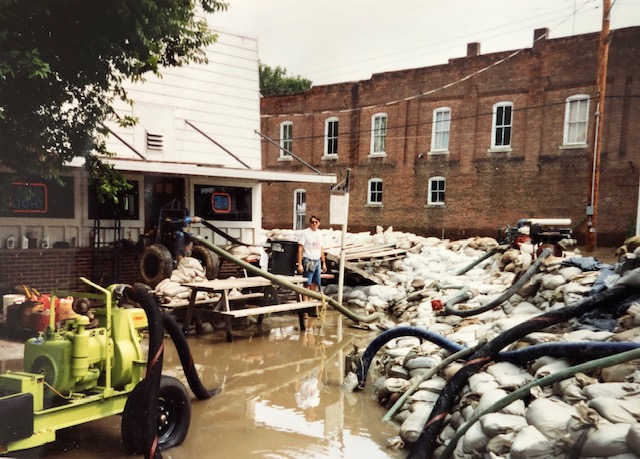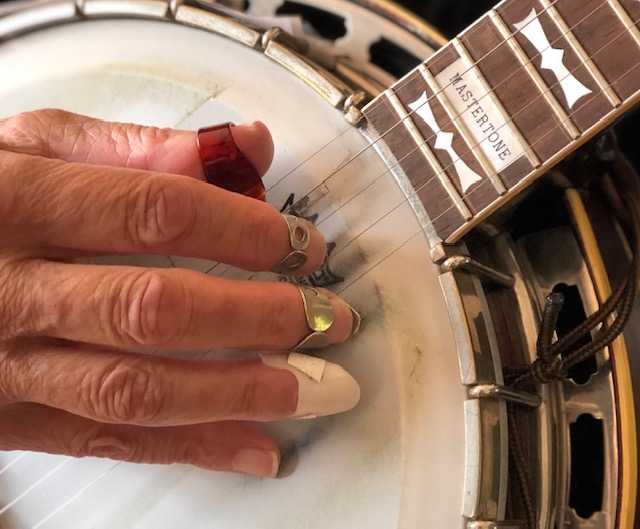In the Spring 1993, the swollen Missouri River rushed over it banks flooding farmland, towns, and cities, and inflicting colossal damage everywhere in its muddy path. About a mile from the river bank, the flood waters surged into the bottomland village of Hartsburg. With the help of farm families, prison volunteers, National Guard, and concerned neighbors, a huge levee was hurriedly erected in the middle of the town with the Hitchin` Post saloon, a Bluegrass jam session venue, just barely on the dry side of the sandbag wall. In a photo taken the morning after the levee successfully stopped the advance of the murky 9 foot deep floodtide, the BRC founder stands up to his ankles in mucky water where he stacked sandbags on the previous day of back breaking work.

Some townsfolk relocated as the flood waters very slowly subsided, but a bottomland farmer was heard to pledge, “River or no river, we`re staying.” The Hartsburg community recovered, and despite minor flooding in 1995, they soon inaugurated an annual autumn Pumpkin Festival to celebrate the town’s resilient agricultural heritage. The BRC founder`s band performed benefits for the Childrens Hospital at the several of these sunny autumn festivals as pictured below (son and father/mandolin far left), but this year`s fest has been cancelled because of the pandemic.

The BRC banjo builder chronicled the `93 Missouri River flood and construction of the sandbag “Hartsburg Wall” in a song with the melody adapted from “Richmond Blues” by T. C. Ashley as recorded by the Smithsonian Institute in 1961.
From a 2004 CD, enjoy this tune in the below sound file in which all music and vocals are performed by the BRC author (copyright 2004).
The clawhammer technique heard in this tune was called “frailing” on Pete Seeger`s instructional album recorded in 1954 that the BRC founder and his older brother checked-out of the local library in 1960 to decode the mysteries of banjo playing. The historic LP “How to play the 5-string Banjo” offered a new vocabulary of hammering-on and pulling-off. The older brother, a seasoned Dixieland jazz musician in college, proposed that it would be more efficient to learn to clawhammer with the ring finger rather than the index digit as Pete recommended on his LP. This would allow the picker to seamlessly shift from frailing to 3 finger Scruggs picking ad lib.

A plastic pick is worn backwards on the ring finger and is stabilized with white electric tape. The thumb pick essentially precludes double or drop-thumbing. Note the subtle clear patch of packing tape protecting the head from thumb pick-tip abrasion. As two-thirds of a banjo`s architecture is a drum, clawhammering with a plastic pick enables banjo volume to penetrate a multi-instrument Bluegrass band or jam session with a percussive galloping rhythm that propels the music. The pre-war Mastertone banjo (photo left) was purchased from progressive NYC banjoist Roger Sprung in 1963 by the older brother who graciously gave it to the BRC founder about 25 years ago.
The pot and resonator were made at the Gibson factory, 225 Parsons St., Kalamazoo, Michigan, in 1928; and the classic “bow tie” RB-250 neck is from the 1950`s. Gibson no longer manufactures banjos, and the “Mastertone” trademark was recently acquired by Gold Tone.From the BRC: Be safe, follow hygiene rules, keep on picking.

No Comments